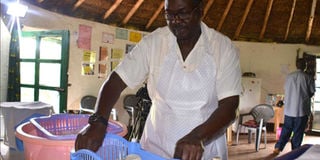Don’t just say cheese, make it from goat milk

Mr. Patrick Wasike packs fresh made goat cheese at his Just Natural Community Based Organisation(CBO) in Kitale town. PHOTO |FILE
What you need to know:
- Wasike, 45, who is based in Kitale and is a trainer in agriculture and rural development, is in the process of making cheese from goat milk.
- The process of making the cheese starts with Wasike testing the quality of milk he receives by checking if there is any bad odour in it or if it is contaminated.
- David Were, a livestock trainer in-charge of dairy goats at the Manor House Agricultural Training Centre, Kitale, says goats unlike cows feed on small amounts of food yet produce prized milk.
Dressed in a white shirt, a blue trouser and a matching apron, Patrick Wasike dips a thermometer inside a blue bucket and reads the temperature.
He then covers the bucket with a white piece of cloth and continues to arrange what looks like dough on a plastic rack.
Wasike, 45, who is based in Kitale and is a trainer in agriculture and rural development, is in the process of making cheese from goat milk.
Through his agribusiness Just Natural, he has perfected the art of making the product.
“I started the project in August 2016 after realising there was good prospects in goat milk.”
However, instead of keeping the animals as many people do or buying and selling raw milk, he saw an opportunity in value addition.
A church organisation with missionaries from Netherlands working in the area provides a ready market for his products.
The process of making the cheese starts with Wasike testing the quality of milk he receives by checking if there is any bad odour in it or if it is contaminated.
However, to be assured of quality, he sources the produce from Crescent Farm in Trans Nzoia, which keeps more than 300 goats.
After collecting the milk, he sieves and boils it, then keeps it under 200C.
“I then leave it for 15 to 30 minutes and introduce rennet, a chemical that coagulates or thickens milk during the cheese making process,” he explains.
The milk curds (solidifies) and he cuts it into various sizes and lets water drain out.
He, thereafter, fills the pieces into moulders to make various shapes of cheese.
“I make the cheese strictly on order but currently I buy five litres of milk a day. This gives me 12 pieces of round cheese each weighing 100 to 110g,” says Wasike, who learnt how to make cheese while working for a Belgian organisation in Uganda.
When the organisation’s project ended, Wasike returned home and furthered his training at the Manor House Agricultural Training Centre in Kitale and later founded Just Natural.
Cheese is one of the best sources of calcium, which plays an essential role in bone development. It is also a source of Vitamin B12, an important ingredient for the function of the nervous system.
Trans Nzoia director of livestock production Barasa Mwombe says most farmers in the area prefer keeping cows than goats for milk yet the latter has great potential.
“Adding value to the milk to make cheese improves its shelf-life and makes it more palatable,” he says.
To consume cheese, one cuts it into small pieces and eats it or you can mix with fruits before consuming.
David Were, a livestock trainer in-charge of dairy goats at the Manor House Agricultural Training Centre, Kitale, says goats unlike cows feed on small amounts of food yet produce prized milk.
He says eight dairy goats can feed on the amount of food a single dairy cow consumes a day.
And that from one dairy goat, a farmer gets two to three litres of milk, which can be equivalent in terms of price to 16 to 18 litres of milk one gets from a cow.
Goat farming as an enterprise, according to him, can do well for small-scale farmers but that those who want to commercialise the enterprise must carry out a market survey to identify market.





